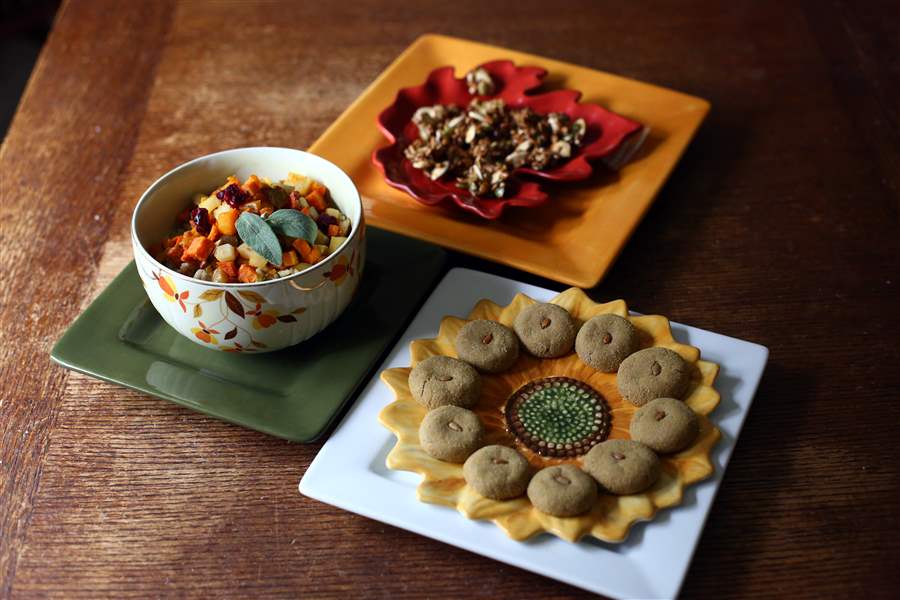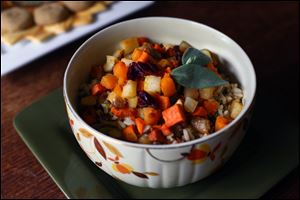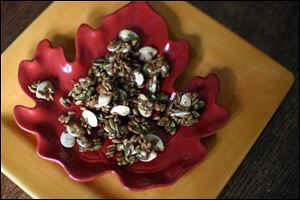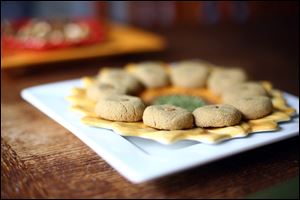
The Sioux Chef: New cookbook shares traditional Native American dishes
10/9/2017
Tatanka Truck Fried Wild Rice Bowl with Maple-Sage Roasted Vegetables, left, Caramelized Seed Mix, center, and Sunflower Cookies, right.
The Blade/Amy E. Voigt
Buy This Image
Indigenous cuisine uses traditional, centuries-old subsistence methods such as foraging, hunting, fishing, and drying — practices that have been seeing a resurgence.
Additionally, as Sean Sherman writes in his first cookbook, The Sioux Chef’s Indigenous Kitchen, “It’s hyperlocal, ultraseasonal, uber-healthy: no processed foods, no sugar, no wheat (or gluten), no dairy, no high-cholesterol animal products. It’s naturally low glycemic, high protein, low salt, plant based with lots of grains, seeds, and nuts.”
And, he continues, “It’s utterly delicious.”
Mr. Sherman is a member of the Oglala Lakota, one of the Sioux tribes, and spent his early childhood on his grandparents’ ranch on the Pine Ridge Reservation in South Dakota before moving to a comparatively larger town after his mother and father divorced. His parents and grandparents “were raised on the reservation,” he said in a phone interview, while his great-grandparents “[grew] up on the plains.”
The family ate a mix of “beef and the game we’d bagged,” he writes in the book, and government-issued canned foods. When he was a child, his grandmother’s “fresh vegetables were a treat, not the norm.”
Later, working at a variety of kitchen jobs in Minneapolis restaurants, he writes, “made up for my lack of formal training.” By the age of 29, Mr. Sherman had earned the position of executive chef. But he was well on his way to becoming burned out from long hours in a stressful career.
So he traveled to Mexico, to the state of Nayarit, for a year’s respite. He writes that in such a remote jungle area, “much of the indigenous foodways have remained intact.” Food “was bountiful, crafted from tradition, cooked with care.”
He worked as a consultant for “a small boutique hotel that sought to reimagine its menu with an extreme local focus.” And that’s where he had “an epiphany,” he writes.
“I tasted how food weaves people together, connects families through generations, is a life force of identity and social structure ... I recognized that I wanted to know my own food heritage.”
As he researched indigenous cooking, history, botany, and stewardship — reading and talking with elders — Mr. Sherman realized “how grossly underrepresented Native American foods are in the United States,” he writes.
And he set out to change that.
“It seems to me to be such a large missing piece of American cultural history,” he said in the interview.
If people are familiar with any native-style food, it is usually fry bread: a crispy, greasy round of dough associated with the Navajo. To Mr. Sherman, it represents “government oppression,” he said. In the book, he writes that it signifies the loss of control over food sourcing and diet when indigenous people were relocated to reservations, leading to poor nutrition and chronic health issues.
There also isn’t just one distinct indigenous food item. “Different foods pop up in different regions and different seasons,” Mr. Sherman said, thus creating tremendous variation from one group to another and throughout the year. It’s extraordinary “how much awesome diversity” there is.
In 2014, Mr. Sherman created and opened the Sioux Chef, “a mission-driven enterprise,” he writes.
Its catering business, created with partner Dana Thompson in Minneapolis/St. Paul, serves traditional items and creative contemporary dishes using pre-European, seasonal foods from the region. The venture’s Tatanka Truck, introduced the next year in conjunction with Little Earth of United Tribes, was named Most Outstanding Food Truck in 2015 by the Charlie Awards, which recognize the very best of the Twin Cities’ food scene.
The food truck has now been placed on hiatus as Mr. Sherman and his team focus on opening two restaurants in Minnesota. (The truck itself has been sold to the White Earth Band of Chippewa Tribe and will serve as a mobile market to an area so devoid of accessible groceries, fresh produce, and cultural foods that 90 percent of it is designated a food desert.) Another project Mr. Sherman has initiated is NATIFS — North American Traditional Indigenous Food Systems, NATIFS.org — a nonprofit dedicated to educational efforts and to helping nurture other native food ventures.
Mr. Sherman has dedicated his book, which was written with award-winning author Beth Dooley, “to our ancestors and all indigenous people who have suffered through centuries of colonialism,” with the hope of reinvigorating their traditions and foods and keeping them relevant and vibrant for future generations.
“That’s why we’re doing what we’re doing,” he said. “There’s just so much more to learn” about the “deep, rich indigenous history.”
Tatanka Truck Fried Wild Rice Bowl

Tatanka Truck Fried Wild Rice Bowl with Maple-Sage Roasted Vegetables.
Sean Sherman writes that “[this] popular Tatanka Truck item makes delicious use of cooked rice.”
2 tablespoons sunflower oil
½ cup minced squash
½ cup minced turnip
1 cup chopped leek, white part only
3 cups cooked wild rice
2 tablespoons maple syrup mixed with ¼ cup water
Salt, to taste
Maple-Sage Roasted Vegetables (see recipe below)
In a large skillet, heat the oil over medium-high heat and sauté the squash, turnip, and leek until tender, about 5 to 8 minutes. Add the rice and cook for about 1 minute, then season with the maple syrup mixture and salt.
Serve topped with Maple-Sage Roasted Vegetables.
Yield: 4 to 6 servings
Source: Adapted from Sean Sherman, The Sioux Chef
Maple-Sage Roasted Vegetables
“Roasting vegetables draws out and evaporates their moisture, condensing and intensifying flavors,” writes Sean Sherman. “Use whatever is in season.”
1 small winter squash, peeled, seeded, cut into ½-inch chunks
½ pound sunchokes, cut into ½-inch chunks (see note)
1 medium sweet potato, cut into ½-inch chunks
½ pound turnips, cut into ½-inch chunks
2 tablespoons sunflower oil
Pinch coarse salt
2 teaspoons chopped sage
2 tablespoons maple syrup
2 tablespoons maple vinegar (see note)
1 teaspoon whole grain mustard
Toasted corn nuts and dried cranberries, for garnish
Preheat the oven to 425F.
Toss the vegetables with enough oil to generously coat. Spread out on a baking sheet so that they are not touching and sprinkle with a little coarse salt and fresh sage. Roast, shaking the pan often, until the vegetables are tender and begin to brown, about 30 minutes.
In a small bowl, mix together the maple syrup, maple vinegar, and mustard and brush over the roasted vegetables. Return to the oven and roast another 7 to 10 minutes to glaze. Remove and serve warm, with garnishes.
Note: If sunchokes are unavailable, substitute jicama or potatoes. Maple vinegar is fermented from the sap collected at the end of the maple season; substitute apple cider vinegar with a bit of maple syrup.
Yield: 4 to 6 servings
Source: Adapted from Sean Sherman, The Sioux Chef
Caramelized Seed Mix

Caramelized Seed Mix.
“These seeds are so delicious,” writes Sean Sherman, “you may find yourself eating the whole pan before they’re served.”
1 cup raw sunflower seeds, pepitas, and/or squash seeds
⅓ cup maple sugar (see note)
In a large, non-stick skillet, heat the seeds over medium-high heat until they begin to smell nutty, about 3 minutes. Stir in the maple sugar, stirring constantly until melted and the kernels are nicely coated. Transfer onto waxed paper or parchment to cool.
These will keep a long time in an airtight container and are great on a salad or as a snack.
Note: If using maple syrup instead of maple sugar, use only half the amount.
Yield: About 1 cup
Source: Adapted from Sean Sherman, The Sioux Chef
Sunflower Cookies

Sunflower Cookies.
“Our signature sweet sunflower cookies are delicious any time of day and are inspired by the sunflower cakes Native warriors relied on for strength and endurance,” writes Sean Sherman.
1 cup Sunny Butter (see note)
¼ cup maple syrup or honey
Pinch salt
¼ cup cornmeal, plus more for rolling cookies
Sunflower seeds, for garnish (optional)
Preheat the oven to 350F.
In a small bowl, stir together the Sunny Butter, maple syrup, salt, and 1/4 cup cornmeal, adding a little warm water if the dough is too stiff.
Using a tablespoon, scoop up balls of the mixture and roll in the extra cornmeal. Place on cookie sheet, garnish with a sunflower seed (if desired), and flatten slightly with your hand. Bake the cookies until just firm, about 10 minutes. Remove and set on a rack to cool.
To make Sunny Butter: Put 1 cup unsalted toasted sunflower seeds into a food processor fitted with a steel blade and grind. Add 1/2 teaspoon coarse salt and 1/2 cup honey and process until a ball forms. Reserve extra for another use.
Note: Commercially produced sunflower butter can be substituted for homemade.
Yield: About 20 cookies
Source: Adapted from Sean Sherman, The Sioux Chef
Contact Mary Bilyeu at mbilyeu@theblade.com, and follow her at facebook.com/thebladefoodpage, bladefoodpage on Instagram, or @BladeFoodPage on Twitter.